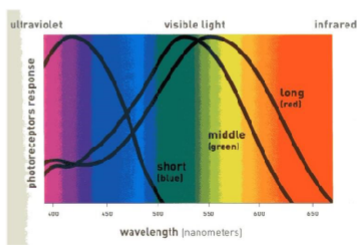Colour vision and perception
1/18
There's no tags or description
Looks like no tags are added yet.
Name | Mastery | Learn | Test | Matching | Spaced |
|---|
No study sessions yet.
19 Terms
where does colour come from?
electromagnetic spectrum (the part our eyes are sensitive to is called visible light)
what is human trichromacy?
the three cone types - maximally sensitive at short (S), middle (M), and long (L) wavelengths

how did evolving a trichromacy help humans?
relates to foraging for ripe fruit/berries
how many cone types do monochromatic primates have?
one
how many cone types do dichromatic primates have?
two (short and medium)
how many cone types do trichromatic primates have?
three (short, medium and long)
what are the genetic colour vision deficiencies?
monochromats (one cone or no cones)
dichromats
anomalous trichromats
what are the types of dichromats?
protanopia - lack L cone
deuteranopia - lack M cone
tritanopia - lack S cone
what are the types of anomalous trichromats?
deuteranomaly (M cone shifted towards L)
protanomaly (L cone shifted to M)
what is the output from the three cones combining and contrasting?
three cone-opponent channels:
L/(L + M) - cherry-teal (or red-green)
S/(L + M) - violet-lime (blue-yellow_
L + M - achromatic or luminance axis (black-white)
how do the cone opponent channels work?
L/(L + M) compares the output of the long wavelength cone with the combination of the long and medium wavelength cone and produces the “cherry-teal” colour dimension
same process for S/(L +M)
L + M is the sum of the long and medium waves and creates the difference between lighter and darker colours (brightness info rather than colour info)
how do the layers/systems in the LGN connect to the colour-opponent cells?
parvocellular = L/(L + M) (cherry-teal)
koniocellular = S/(L +M) (violet-lime)
magnocellular = luminance (black + white)

as well as having orientation selective neurons, what other type of neurons does v1 have?
colour selective neurons (patches of cells/”blobs” that are responsive to colour)
which other parts of the visual cortex have been associated with colour processing?
v2, v4, and v8
what is cerebral achromatopsia?
loss of colour perception due to damage to small cortical region
what is memory colour?
some objects have a typical colour that we learn from experience and expect (this error is not present for a simple circle of colour)
how does the ecological valance theory explain colour preference?
colour preference due to colour-object associations (i.e. good/bad objects associated with certain colours)
how does nature affect colour preferences?
natural scenes tend to be dominated by blue-yellow variation which is also the type of colour pattern which people like the most
what is colour constancy?
the brain’s ability to subtract the illumination and recover the true surface colour